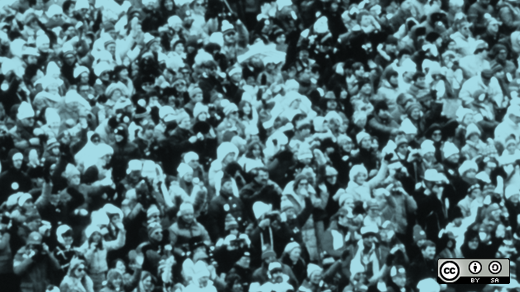Anthropologists who traveled to the jungle to study various tribes would debate (half jokingly) whether to "go native"—that is, whether to adopt the lifestyle of the people they were trying to understand, or to keep their distance (and scientific objectivity). It was a research design choice, but also a fundamental choice about one's identity as a more-than-interested visitor.
Leaders in the new world of networks and virtual communities face a similar identity choice. With more leaders taking advantage of informally connected talent, the "wisdom of crowds," and open source innovation, how much should they try to "go native"? Should they operate as members of the networks they want to work with them? Or should they somehow try to manage them from the outside?
Networks, communities, and Joy's Law
At first, it might seem like a false choice. Common wisdom says networks can't be managed, that they're allergic to leadership of any kind. But today many leaders clearly take advantage of informal and open source networks for achieving their strategic goals. In some cases they take the "native" route and act as "members," using their personal influence or relationships to mobilize other talented "colleagues" to pursue a project with them. In other instances, they stand apart but offer soft and hard incentives to engage a network or community of volunteers to come on board. In both cases, they are (in some sense of the word), leading a network. It's a challenge more and more leaders are taking on, realizing that a decade ago Bill Joy got it right: in the talent-rich but more loosely organized and hyperconnected world, "most of the smartest people don't actually work for you." But as a leader you still have to figure out how to make them part of what you're trying to do.
Red Hat is Exhibit A for Joy's Law. Many of the smartest people in the Linux software movement don't work for Red Hat's CEO, but the company depends on networks of volunteers to pursue its strategy of providing value-added integration products. And that's presumably why Red Hat's culture echoes many of the same freedom-loving, self-governing, open source values of the movement itself. Both movement and corporation are comprised of networks of people with knowledge, experience, and critical relationships keyed to the success of Linux. They share methods for working and seeing the world that old-time anthropologists might call positively tribal.
Going native (or not) at Red Hat
So unsurprisingly, the question of whether to "go native" was an early threshold choice for Jim Whitehurst, as the Red Hat CEO recounts in his lively new leadership meditation, The Open Organization. The book is a fascinating case study of leadership in a network-centric world. From the day Whitehurst started interviewing, he saw that to get the CEO job (and thrive in it) he would have to become part of open source culture—a culture radically different from the one he previously commanded-and-controlled (as COO of Delta Air Lines). Gone were the privileged parking, corner office, and habitual employee deference of the gentile airline company. Welcome to networks of initiative, anywhere/anytime debates, meritocracy regardless of position, and strong community-style values.
And Whitehurst embraced them all with the increasing zeal of a missionary. The book features anecdote after anecdote of the wisdom of going native. It praises the ways opinionated Red Hatters have taught him how a contrarian idea can yield a better result; it reflects on how a deeply experienced engineer persuaded him to reverse a major software decision; it ruminates on how designing programs with mass participant involvement creates more value for all involved. Jim Whitehurst's glass overfloweth with the people-centric Kool-Aid of network and open source thinking: when those with knowledge and stake in a major new direction help design it, the change always goes more smoothly.
The world already contains plenty of management lore about the benefits of "empowered workplaces." The more interesting question is how best to achieve that objective when one is still CEO with a certain obligation to "control" people who do, well, ultimately report to you. How, in fact, does a leader of networks keep from "turning the zoo over to the animals" (to borrow one of Whitehurst's own phrases)? When and how does one need to stop "going native" and return to one's identity as The Boss?
Experimenting with role and identity
Here Whitehurst's book is less expansive than one might wish. But clearly his leadership journey has involved the constant experimentation with role and identity typical of someone who is sometimes in charge and sometimes only barely so. His stories are full of paradoxical reference to both hierarchical positions in the company (head of this or that function; "senior leadership team") and leadership based on community meritocracy. He sometimes describes himself as CEO and other times simply "a leader" (singular, i.e. one of many at Red Hat); still other times he just seems like one of the crowd.
But The Open Organization does offer valuable insights about managing the inevitable native and non-native tensions of someone attempting to foster networks and communities while also leading a public corporation. Sometimes Whitehurst simply has to step out of the community role and be CEO for reasons of external accountability (e.g., to shareholders or regulators). The "leader," as this CEO also writes, must ensure that all the company's great engagement company gets "scaled up" (e.g., by creating platforms of communication). That leader, more than any member of the community, must also ensure that energetic debates about work don't become personally toxic or chaotically spin out of control; he or she must channel the cultural passion and purpose of the organization in ways that actually drive company success. CEO, not community native, must set limits to how much "creative time" associates spend on "what-if" projects that might not yield real ROI.
This Red Hat leader is most explicit when he discusses the classically hierarchical concept of "setting direction for the organization." Here Whitehurst insists his role is not like Jack Welch at GE (or most other CEOs, for that matter); rather, he acts as a "catalyst: an agent that provokes or speeds change or action." Sometimes he's just one more native helping to foment a productive revolution; other times he's curating and gently controlling the ever-creative crowd.
Leadership and boundaries
Whitehurst's identity as a leader (one he humbly concedes remains a "work in progress") is full of tension, and the real source of this tension is clear: Though this CEO defines the "open organization" as one that engages "participative communities both inside and out," he still references a boundary between internal and external communities. Even though he embraces open source culture, Whitehurst is actually overseeing one community of networks (Red Hat) within a broader collection of even more networks (like the Linux movement, over which he has little control). Both must be engaged—Red Hat services are dependent on the broader "product" of the movement—but the CEO's ultimate loyalty must be to the more immediate stakeholders of the corporation: employees, shareholders, and formal partners of Red Hat. Red Hat (the corporation) ultimately does require more traditional supervision than the open movement would ever allow.
The high wire act
Judging by the company's performance, Whitehurst must certainly be managing the native/non-native identity question. As an outsider looking in, I'd guess he's finding just the right balance between joining the tribe and making sure it achieves the right kind of accountable collaboration to grow and thrive.
It's a high-wire leadership act that bears further observation. In the new open source and hyperconnected world, leaders must practice managing concentric circles of collective community production—and navigating the balance between "freedom" and "accountability." Joy's Law will become ever more true. The need for leaders to reinvent their mindsets and behaviors will only become more critical. Network leaders everywhere should hope for a second volume of The Open Organization.
Follow the conversation on Twitter #theopenorg






Comments are closed.